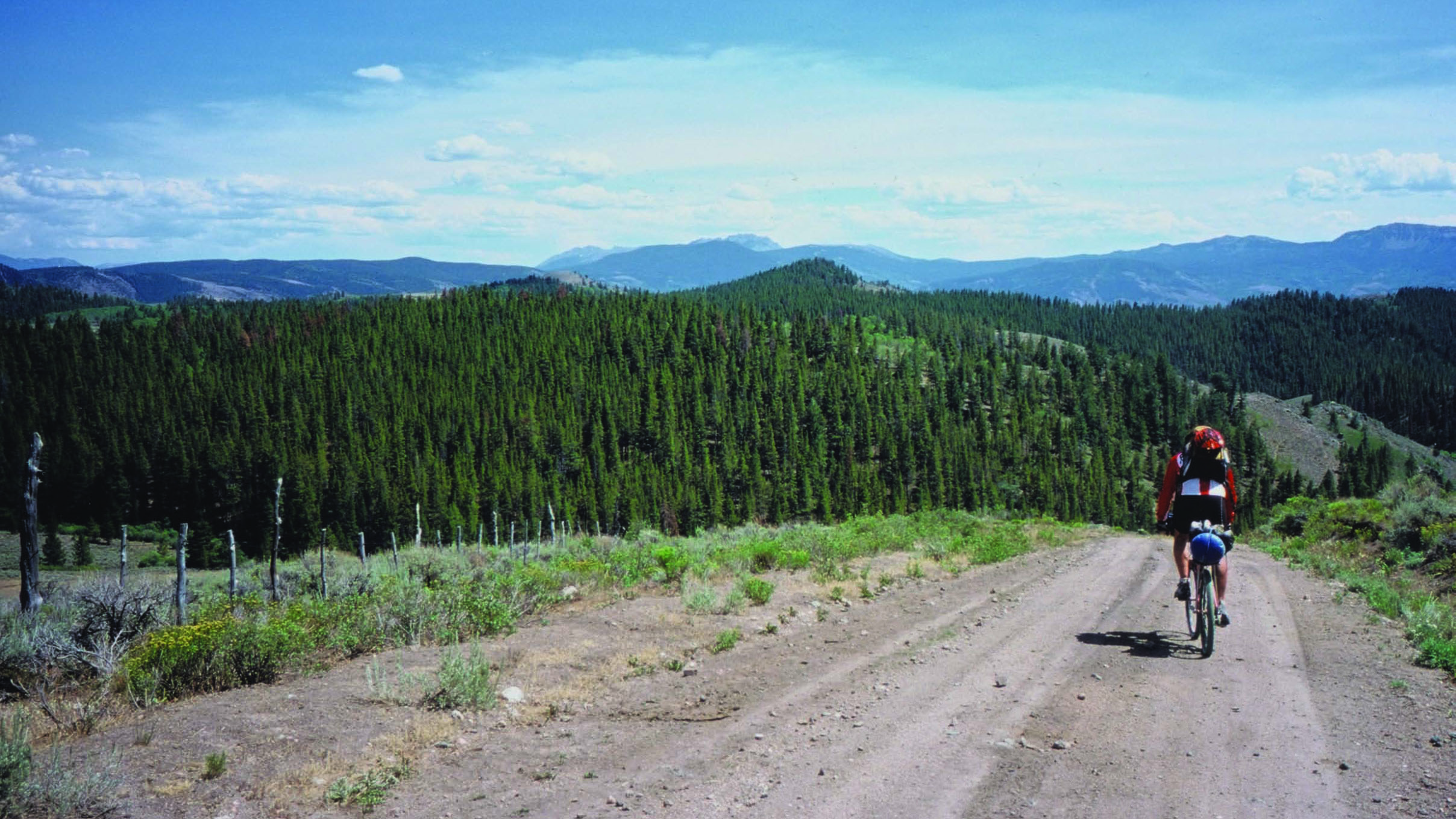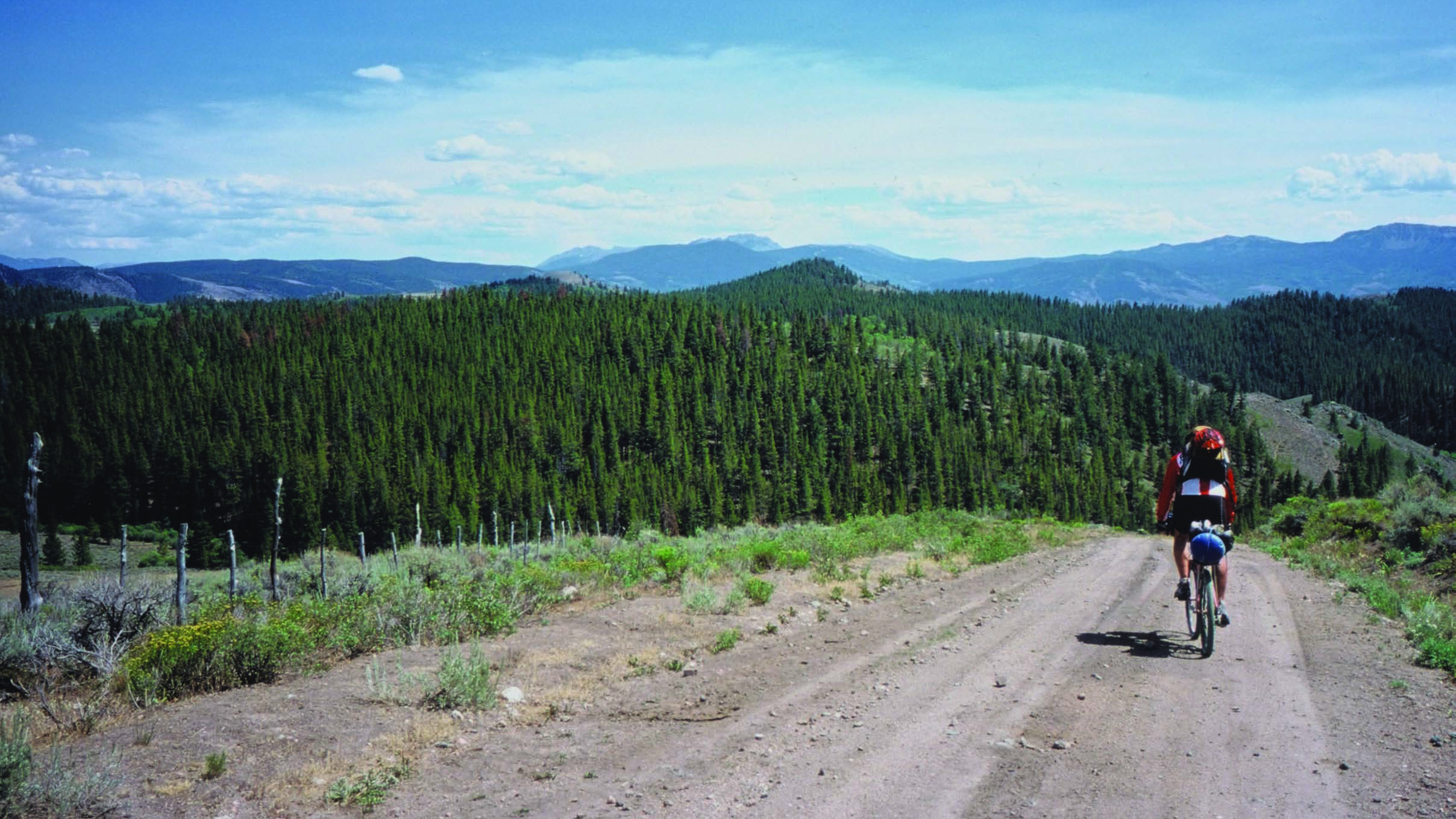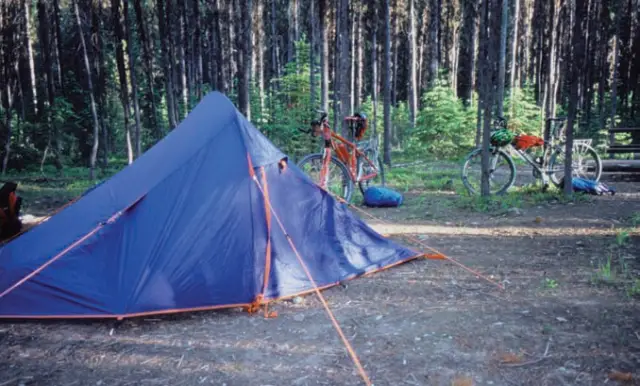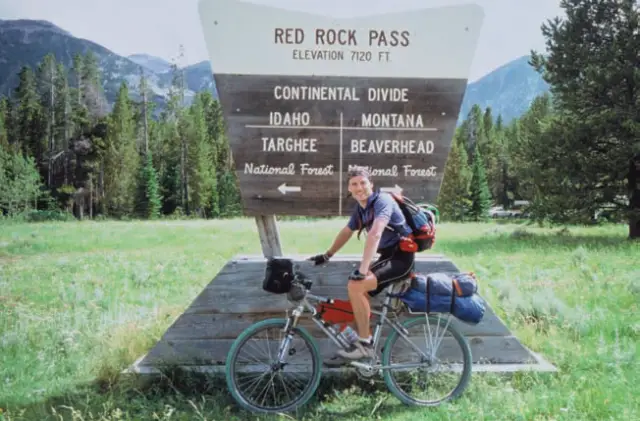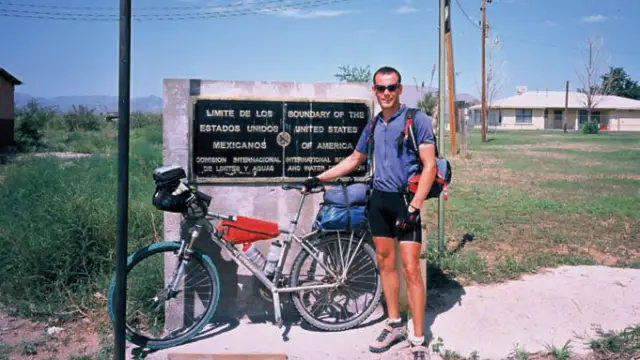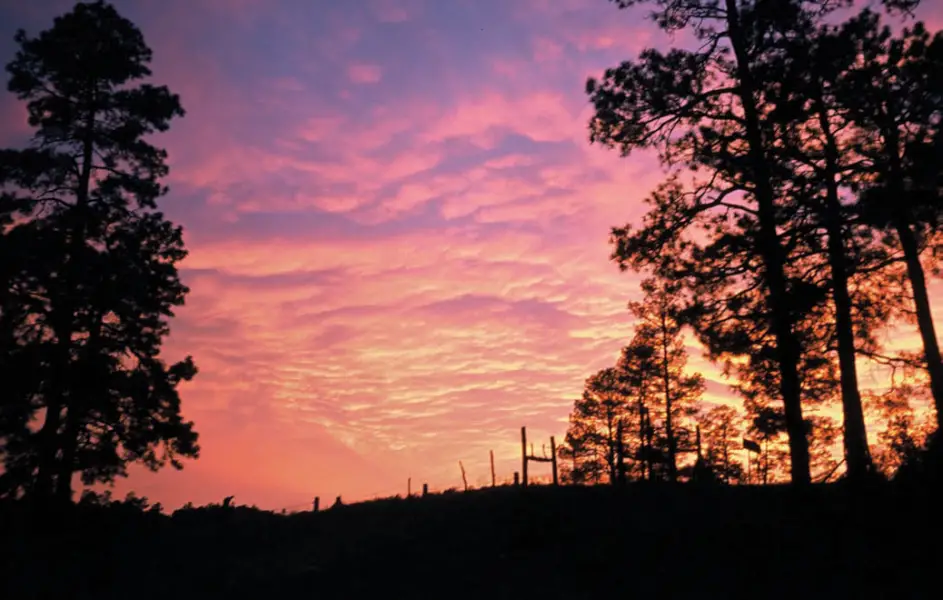In this episode of our look back at [echo] Stories From The Paaaaast [/echo] we join John Metcalfe on his ride of the Great Divide trail, from Canada to Mexico. And what’s more, just for this extra special edition of Throwback Thursday, you don’t even need to be a subscriber! So grab a cuppa, put your feet up (as long as the boss can’t see you) and enjoy…
By the end of the first day it was glaringly apparent that I was out of my depth.
As I lay in a stifling tent – pitched on the side of a trail somewhere in Montana – I had the rest of the evening and the whole of the night to reflect on my folly.
For the best part of a day John Kelly (JK) and I had wrestled our bikes up an improbably steep climb under an improbably hot sun. We were forced to call it a day after only 40 miles, which I lamentably calculated as being less than one-tenth of one percent of our intended journey – the journey in question being the Great Divide Mountain Bike Route.
The GDMBR is a 2500-mile off-road ride along the spine of the Rockies starting at the Canadian-American border and finishing in Mexico. Adventure Cycling heralds it as America’s premiere long-distance mountain bike route. It is the longest unbroken mountain bike route in the world, and it was recently included in National Geographic’s list of the 50 most amazing ‘places’ on earth. Considering what else is out there, that’s a fairly bold claim.
That said, the stats of the route are pretty impressive: on its journey from Canada to Mexico, it criss-crosses the Continental Divide no fewer than 26 times, and passes through five states. And what’s more, ninety percent of it is on dirt.
I first read about the GDMBR in a short article on the internet, and because I secretly harboured a desire to discover a latent (albeit late) talent for endurance mountain biking, I decided there and then that I would do it.
Working on the premise of safety in numbers I cajoled (perhaps coerced is a more appropriate word) my greenhorn friend JK into accompanying me. Several months and many credit card transactions after making the initial decision, we found ourselves transported from my idyllic cycling dream into the harsh reality that is known on the trail as ‘bikepacking’. And we were quick to realise that it was bloody hard work.
Hard work ahead
Hard work it was, and hard work it was going to be for the foreseeable future. In five weeks’ time we had a plane to catch from El Paso, and the only way to get there was by bike. This being the 21st century, there are of course many other ways of getting to El Paso on time, many including internal combustion engines, or even jet propelled ones. But these options were already non-starters as I had done something foolish before I had left the UK: I had naively bragged about my proposed two-wheeled feat. Worse still, I had berated others for not attempting such things in their own mundane and slovenly lives. In my roasting nylon dome, the reason why they hadn’t became all too apparent, and boy was I envious. In order to return to Blighty and avoid a berating myself, I had to ride the length of the GDMR. That, and the fact that I couldn’t afford any other transport.
In the roasting nylon dome the reason why they hadn’t became all too apparent, and boy was I envious.
Unsure whether avoiding being eaten by a bear during the night was a blessing or not, I set off on the following morning in a befuddled state. Visions of TV interviews, extortionate sponsorship deals and lunch-on-the-lawn with the mayor upon completion of my heroic quest soon evaporated. They were replaced with more pressing goals such as: finding water, procuring nappy cream for my tenderised arse, and above all getting my odometer into triple figures. I reckoned quitting the ride without having broken a century was the Great Divide’s equivalent of getting a duck in cricket…
Whose idea was this anyway?
The route was first pieced together by Adventure Cycling Association back in the mid nineties, but it wasn’t until 1997 that Drew Walker, a courier from Washington, DC, first rode the entire route. Two years later ultra-endurance legend John Stamstad completed his record setting end-to-end time of 18 days and five hours.
The route is dramatic. The skies are big. The climbs are huge. And the scenery is diverse. The remit for the GDMBR is: ‘to follow the Continental Divide as closely as possible’ and it does so with gusto. The Continental Divide is an imaginary line through North America that marks the flow of water. Rain falling on the east of the Divide finds its way to the Atlantic and that on the west ends up in the Pacific Ocean. Because of this, the route follows high ground and there is over 75,000 feet (or three Everests’ worth) of cumulative climbing during the entire route.
The trails are a hotchpotch of historical routes including those forged by Lewis and Clark (and the Corps of Discovery) during their expedition into uncharted territory; derelict railway beds last used during the Gold Rush era; Old Pony Express trails, and Beefsteak trails used by cowboys to herd cattle from one state to another. These are linked with more contemporary forest paths, four-wheel drive tracks and fire roads.
The GDMBR bisects North America, and as a traveller you are treated to a diverse taste of the country. No two days in the saddle are the same – apart from being an incredible experience. The flora and fauna continually change providing you with the opportunity to ride diverse trails and encounter numerous critters such as bears, deer, moose, rattle snakes and – worst of them all – mosquitoes. You’ll pass through: towns, hamlets, national parks (including Glacier, Yellowstone, and Grand Teton), deserts, Indian reservations, and ghost towns. You’ll also be on the receiving end of a wide spectrum of weather including: cold, heat, snow, hail, rain, thunderstorms and a ubiquitous headwind. And sometimes you’ll experience all of the above in a single day.
Despite the diversity, there is one constant (wind and mosquitoes notwithstanding), and that is the rewarding mountain biking that the route has to offer. After only a few miles south of the Canadian border you’ll find yourself inching your way up the steep climbs, deep in the dense woods surrounding Glacier National Park.
…cold, heat, snow, hail, rain, thunderstorms and an ubiquitous headwind – sometimes all in a single day…
This introduction to the Montana wilderness is a tough one. It takes time to adapt to the climbs, the heat, the increasing altitude and the long days in the saddle. However there are many things to distract you from your toils, namely grizzly bears, mountain lions and cantankerous moose.
You’ll be battling with the terrain, but you’ll also be battling against the clock. As a through-biker (the name given to those who ride the entire route end to end), you’ll want to begin the journey as early as you can so as to time it right through the high passes in Colorado (which are snow-free for only a few weeks a year). You’ll also want to avoid the monsoon weather during late summer in New Mexico. But it is not uncommon for there to be snow in the Montana mountains as late as mid-June, which can mean that a late start is inevitable.
Montana – ‘Big sky country’
Montana is a beautiful state and the riding is typified by a long climb out of one town followed by a long descent into another. The towns aren’t the sprawling billboarded Metropolises that fit the American stereotype. Instead they are small towns with a friendly feel to them. Indeed the largest Montana-town on the route is Helena and it has a population of less than 40,000. As you head south, you’ll pass Yellowstone National Park and it goes without saying that the scenery and the riding here is awe-inspiring, comprising of forest tracks and beautiful meadows. It’s also steep.
Butte is the other major Montana town on route and it serves as a warning as to what can happen if commercialisation is left unchecked. Huge open mines have scarred the landscapes, and the mining processes used to extract the precious metals have poisoned the land. Fortunately the destruction is short lived and you’ll soon find yourself pedalling through Yellowstone Park (inspiration for Jellystone, the fabled home of Yogi Bear), and squeezing past the Grand Teton National Park.
As you leave Montana you will get a brief flavour of Idaho as the route cuts across the top right hand corner of the state before entering Wyoming. The Wyoming countryside is characterised by wide valleys that have an Alpine feel to them; the climbing is protracted and the air is a lot thinner. The increasing altitude won’t be your only adversary while in this state – you’ll also have to contend with the Wyoming headwind (which has gained notoriety among GDMBR bike packers) and the relentless savagery of the mosquitoes and deer flies.
Top five food groups:
- Ibuprofen – wouldn’t start the day, or sit on the saddle without a handful.
- Coffee – an excellent crutch during those 14 hour plus shifts.
- Little Debby Snacks – readily available pastries with a phenomenally dense energy concentration.
- Boxes of Ritz Crackers – helps to solidify the number twos after you’ve been desperately drinking dodgy water out of a cattle grid.
- Fig Newtons – Helps to de-solidify your number 2s after your gut has gone haywire (from too many Ritz Crackers – Ed).
Stocking up on supplies
Camping is readily available throughout Wyoming, usually in the form of primitive campsites or trailside pitches. Generally the towns are separated by a few days’ worth of wilderness riding, which necessitates having to stock up on supplies before leaving each one. Most towns have a mercantile store where you can pick up groceries but few have a bike shop. Surprisingly, there are very few bike shops along the route – and the ones that do exist tend to be several hundred miles apart, and often requiring a circuitous detour. Camping is readily available throughout Wyoming usually in the form of primitive campsites or trailside pitches.
Here, rainwater does not flow to the oceans, but leaches into the parched soil.
Finding water will be one of your daily chores and it can usually be sourced from one of the many creeks that proliferate the area. It’s a simple case of filling up your water bottles and hydration bladders and adding a couple of iodine tablets and the job is done. That is, apart from the Great Divide Basin. Wyoming houses one of the two deserts that you must cross as you ride the plumb line through America. The Basin is an arid stretch of wasteland with negligible drinking water. Here rainwater does not flow to the oceans but leaches into the parched soil. While keeping an eye out for water you’ll no doubt catch a glimpse of the wild horses and pronghorns that roam these plains.
Top of the trail
The penultimate state is Colorado, and it is home to the apex of the route. Here you will encounter long climbs and high mountains, culminating at Indiana Pass – the highest point on the route at a few pedal strokes under 12,000 ft. Colorado feels less remote than the other states and the townsfolk are friendly and welcoming. Places like Breckenridge and Silverthorne are renowned ski resorts, and what makes for good skiing in the winter makes for good mountain biking in the summer. The riding is beautiful and you’ll pass through stunning Aspen groves and picturesque meadows on quintessential single track.
Once into New Mexico the terrain becomes rockier and drier, and water becomes increasingly scarce. Despite this most through riders agree that is the best state on the route. One of the reasons is that New Mexico is a visual feast. Whereas in other states the scenery rarely changes, in New Mexico there always seems to be something new. Mountain ranges, desert, mesas, intriguing rock formations and bluffs make up the backdrop. Two other reasons are: that the climbs are shorter, and that the end is in sight. New Mexico contains the second of the desert crossings – this time you’ll have to cross the Chihuahuan Desert with its dry sandy trails complete with cacti.
New Mexico has two prevailing influences: a strong Spanish accent harking back centuries to when the Conquistadors discovered the New World, and a rich Native American culture, both of which add an interesting historical dimension to the trails. The hills gradually lessen and once again water becomes more prevalent. Then it’s the final ride into Antelope Wells, your destination at the American-Mexico border.
The route is hard and unforgiving both on rider and on bike. It is a mental challenge as well as a physical one. You must choose the correct equipment, the correct route, you must decide on the best strategies for food and water. You must motivate yourself day after day. And of course you have to pedal. For every ounce of energy you expend your efforts will be redoubled with the rewards that this route holds in store. It is an experience you’ll never forget.
The Great Divide Mountain Bike Route has it all. So yeah, it does have a claim on the audacious title of being America’s premiere mountain bike route, and it is certainly one the most amazing places on earth
John’s tips on how to survive the GDMR
After five weeks on the trail our odometers eventually nudged their way up to the 2500-mile mark and we finally arrived at Antelope Wells, our destination. Between us the journey was singularly the best thing we had ever done and was a truly awesome, life changing experience. The trail taught us a lot, so if you’re thinking of having a go, here are some of my ups, downs and general tips:
Top Five Highs
- Strangers going totally out of their way to help us.
- Riding a 20 minute off-road descent without having to pedal.
- Camping in the desert.
- Cresting Indiana Pass, the apex of the route, at 12,000ft.
- Arriving at Antelope Wells, the fabled end of our journey.
Top Five Lows
- Realising I had put JK’s cycling shorts on by mistake.
- Arriving at Antelope Wells and realising it was over.
- Being very, very thirsty and drinking out of a cattle grid.
- Enjoying a twelve-mile descent, then realising we had gone the wrong way and having to retrace our steps.
- Getting twelve punctures in one day.
Top Five Tips:
- Do the ride. You won’t regret it.
- Don’t take a trailer, pack light – it’s amazing what little kit you need.
- Learn the lyrics to more than one song, it will stop you irritating the hell out of your mate.
- Always top up your water at every opportunity.
- Lift your head up off your barbag once in a while and you might get to see the amazing scenery.
Top five bits of kit:
- The invaluable maps and guidebook published by Adventure Cycling (http://www.adventurecycling.org/)
- Nappy cream – learn from the experts; if babies can sit in their own excrement all day it’ll work for you.
- Endura MT500 shorts – top quality padding for your number one contact point.
- Baby wipes, or ‘instant showers’ as they became affectionately known.
- Other riders’ trailers. We opted not to take trailers and travel light, but mercifully every other rider we passed on route had a trailer typically laden with all kinds of goodies. Like bacon. Mmmm.
By John Metcalfe
